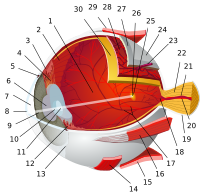Iris dilator muscle
[6] Thus, when presented with a threatening stimulus that activates the fight-or-flight response, this innervation contracts the muscle and dilates the pupil, thus temporarily letting more light reach the retina.
The pupillary dilator acts to increase the size of the pupil to allow more light to enter the eye.
[7] Pupil dilation occurs when there is insufficient light for the normal function of the eye, and during heightened sympathetic activity, for example in the "fight-or-flight reflex".
[13] In the medical writings of Aulus Cornelius Celsus we can also find this specific name to refer to a muscle instead of its literal meaning.
[13] The other explanation[14] considers dilatare as a compound from di- and latus, with the latter word meaning, broad or wide,[13] hence the German name Erweiterer for Latin dilatator.

